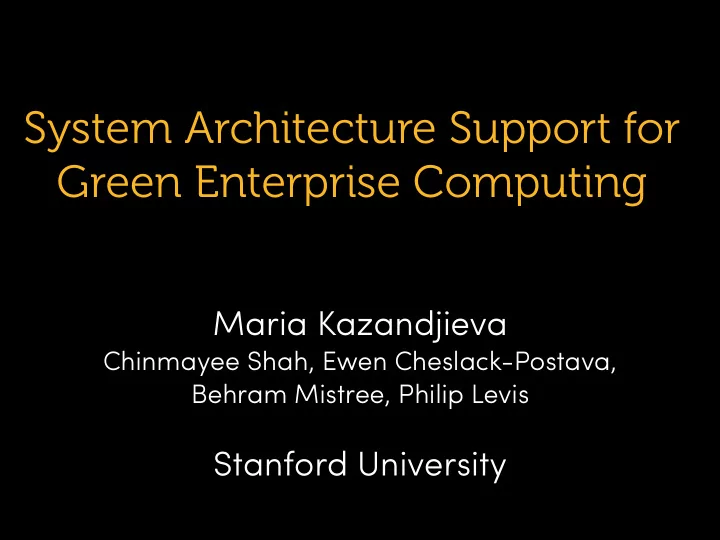

System Architecture Support for Green Enterprise Computing Maria Kazandjieva Chinmayee Shah, Ewen Cheslack-Postava, Behram Mistree, Philip Levis � Stanford University
Computing systems account for an estimated 13% of the electricity use of o ffi ce buildings. [DoE] � This amounts to about 2% of the total electricity consumption in the US. 2
3
O ffi ce PCs spend the majority of their time at very low CPU utilization. 4
O ffi ce PCs spend the majority of their time at very low CPU utilization. Percentile CPU Machine 5 50 95 Dell Optiplex 745 1% 9% 58% High-end custom-built 0% 1% 57% Dell Precision T3400 0% 4% 29% 0% 0% 25% HP Pavillion Elite m9250f Dell Precision T3400 0% 1% 13% 1% 1% 8% Dell Inspiron 530 Dell Precision T4300 0% 1% 7% 4
� � two-thirds of o ffi ce PCs have CPU<10% 75% of the time
1 Why is low desktop utilization a problem? 2 What about other, greener hardware? 3 A hybrid solution 4 Takeways 6
ideal power 0% utilization 100% 7
165 W desktop 110 W ideal power 0 W 0% utilization 100% 7
165 W desktop 110 W ideal power 0 W 0% utilization 100% 7
Hardware is not power-proportional � so low utilization means a lot of waste. 8
Hardware: Thin Clients No local compute resources Displays the GUI of a remote machine. � 15-20 watts for client itself 10-15 watts server share 9
Hardware: Laptops 10
Laptops performance << desktops � Thin Clients not suitable for all workloads 11
Laptop power ≈ Thin Client power 12
1 Why is low desktop utilization a problem? 2 What about other, greener hardware? 3 A hybrid solution 4 Takeways 13
A hybrid compute architecture can save as much energy as a thin client without sacrificing performance. 14
Anyware combines low-power clients with a high-end shared server. 15
Anyware low-power client VM VM VM high-end shared server 16
1. Double-click to watch a video VM VM VM 17
1. Double-click to watch a video 2. Decide to use local resources to play the video VM VM VM 17
1. Double-click to watch a video 2. Decide to use local resources to play the video 17
1. Double-click to edit an image VM VM VM 18
1. Double-click to edit an image 2. Decide to o ffl oad the task VM VM VM 18
1. Double-click to edit an image 2. Decide to o ffl oad the task VM VM VM 19
How do we build Anyware so that � it is invisible to the user and it does not require application or OS changes and it is practical and easy to setup? 20
create a bare-bones VM that matches VM the client OS and architecture 21
create a bare-bones VM that matches VM the client OS and architecture connect the VM and client via SSH and export the VM windowing system 21
create a bare-bones VM that matches VM the client OS and architecture connect the VM and client via SSH and export the VM windowing system identify files and folders that the client will export to the VM via a networked FS 21
O ffl oad complete program execution. � Do so in user space by anyware.desktop intercepting MIME type association. 22
But wait, Who will decide where task are executed? � Will remote execution impact user experience? � 23
User Study Tasks Application Features instructions executed IPC cache misses X drawing calls local: data read remote: network data in/out 24
Qualitative Results From a user perspective, the majority of applications perform similarly, regardless of whether they run on a laptop or on a remove VM. � Tasks that are data— or graphics—heavy, have visibly worse performance when executed remotely. 25
A logistic regression model suggests a small set of workload features are indicative of where a task should be executed. number of instructions Remote Mb sent from client to VM Mb sent from VM to client Local number of subprocesses 26
Hardware Setup 2-core, 1.6 GHz 4 GB RAM 256 GB SSD Intel Xeon VM VM VM Server 12-core, 3.0 GHz 4-core, 2.4 GHz 48 GB RAM 4 GB RAM 7200 RPM HDD 256 GB SSD four cores VM 4 GB RAM 27
Spreadsheet Task 28
Image-processing Task 29
Text Edit Task 30
A Video Workload
A Video Workload Anyware desktop local remote frames not 0% 0% 32% displayed 32
A Video Workload Anyware desktop local remote frames not 0% 0% 32% displayed Anyware will choose to run this locally 32
Energy Evaluation 14 - 24 W (no screen) Intel Xeon Server VM VM VM 130 - 270 W 110 - 165 W 5 - 11 W VM (assuming 25 VMs) 33
Energy Evaluation 165 W Desktop � 110 W 100% active 35 W 19 W 34
Energy Evaluation reduction of 68% - 77% 165 W Desktop � 110 W 100% active 35 W 19 W 34
Anyware A practical system that uses established techniques to provide performance comparable to that of desktops while reducing energy costs by ~ 70% 35
Final Thoughts The computing design space is large and the trade-o ff between power and performance is not linear. 36
Final Thoughts Time to rethink the needs of enterprise computers: � local: graphics, I/O, network, memory remote: cpu, memory 37
Recommend
More recommend